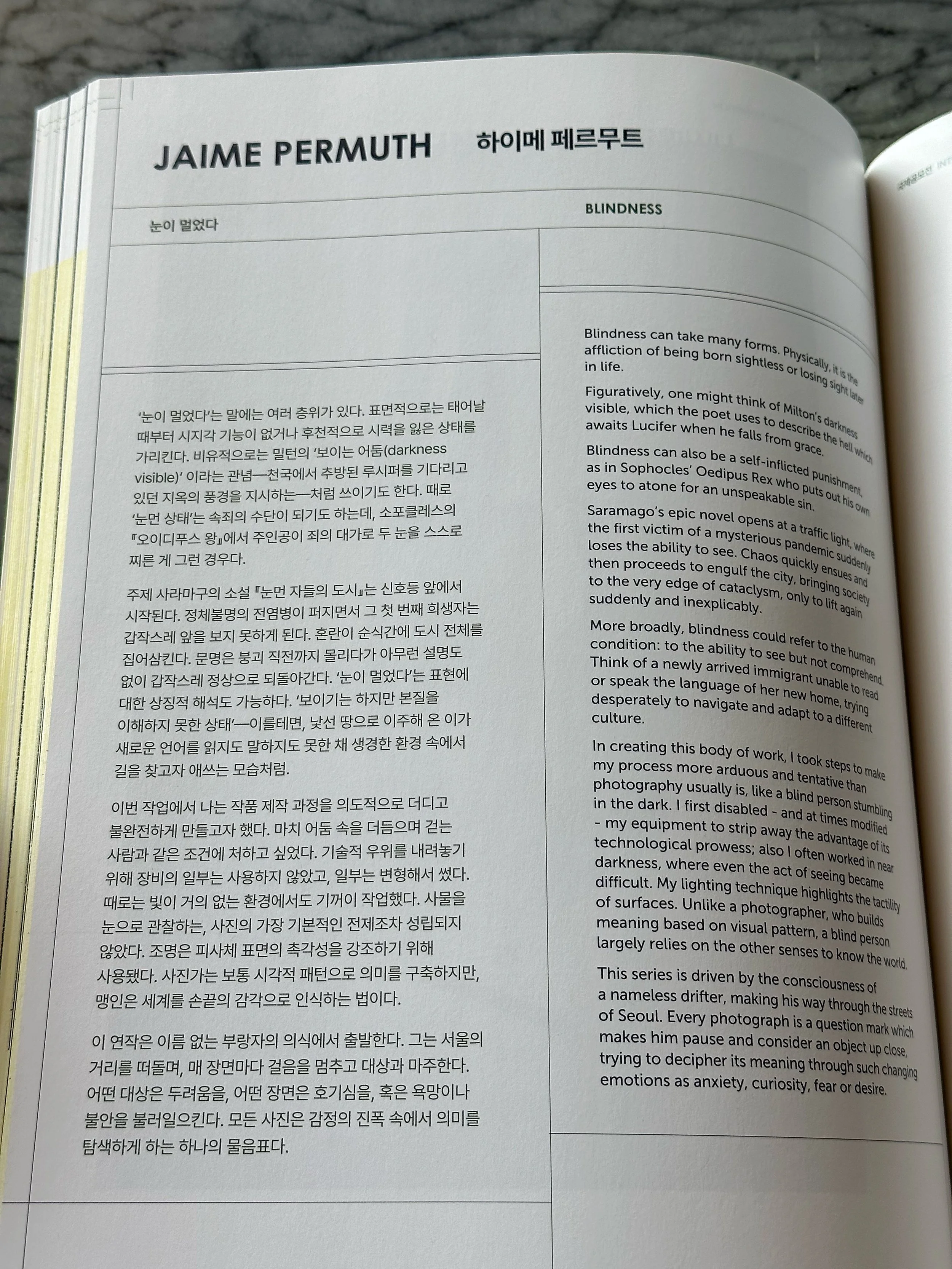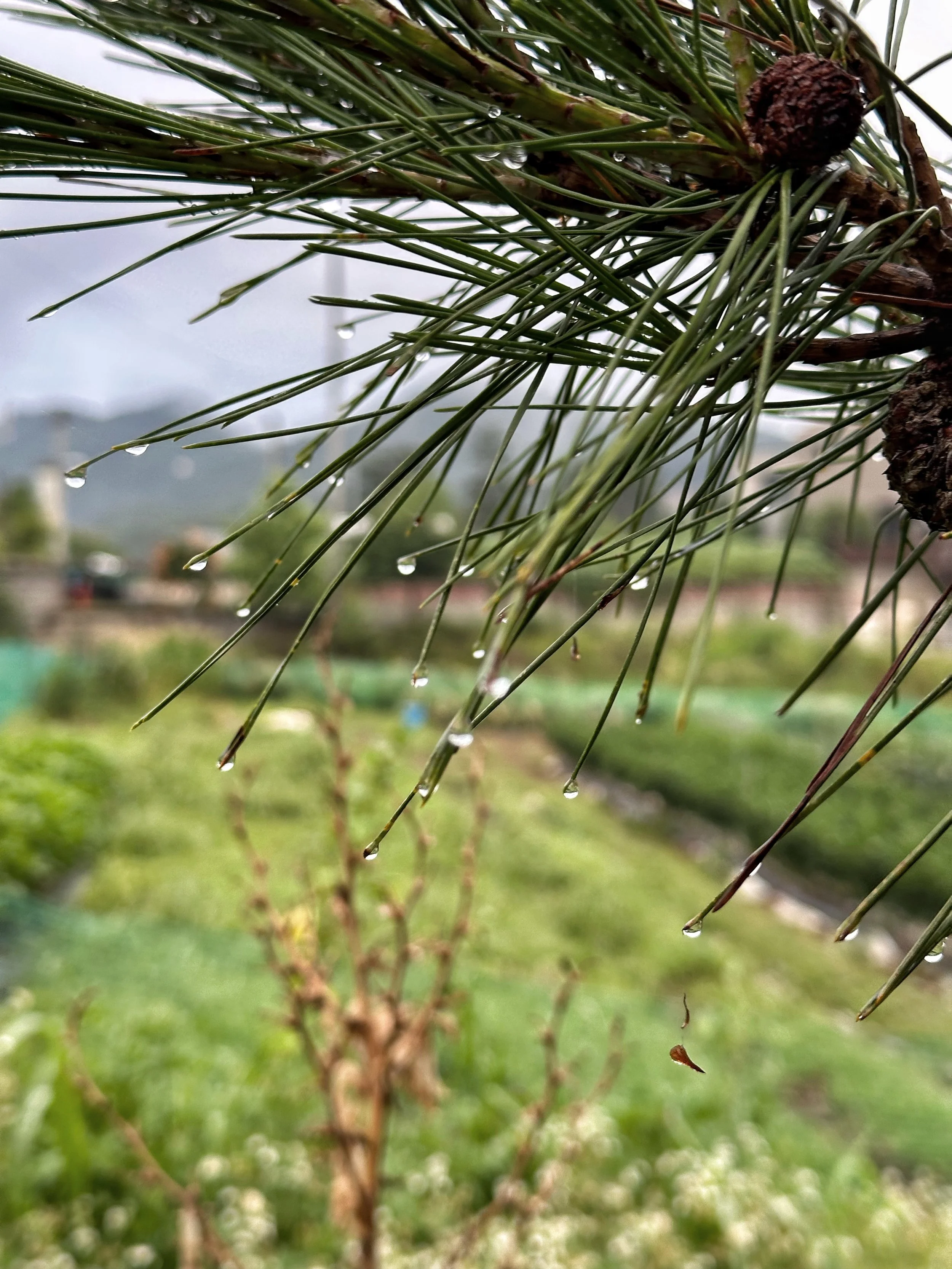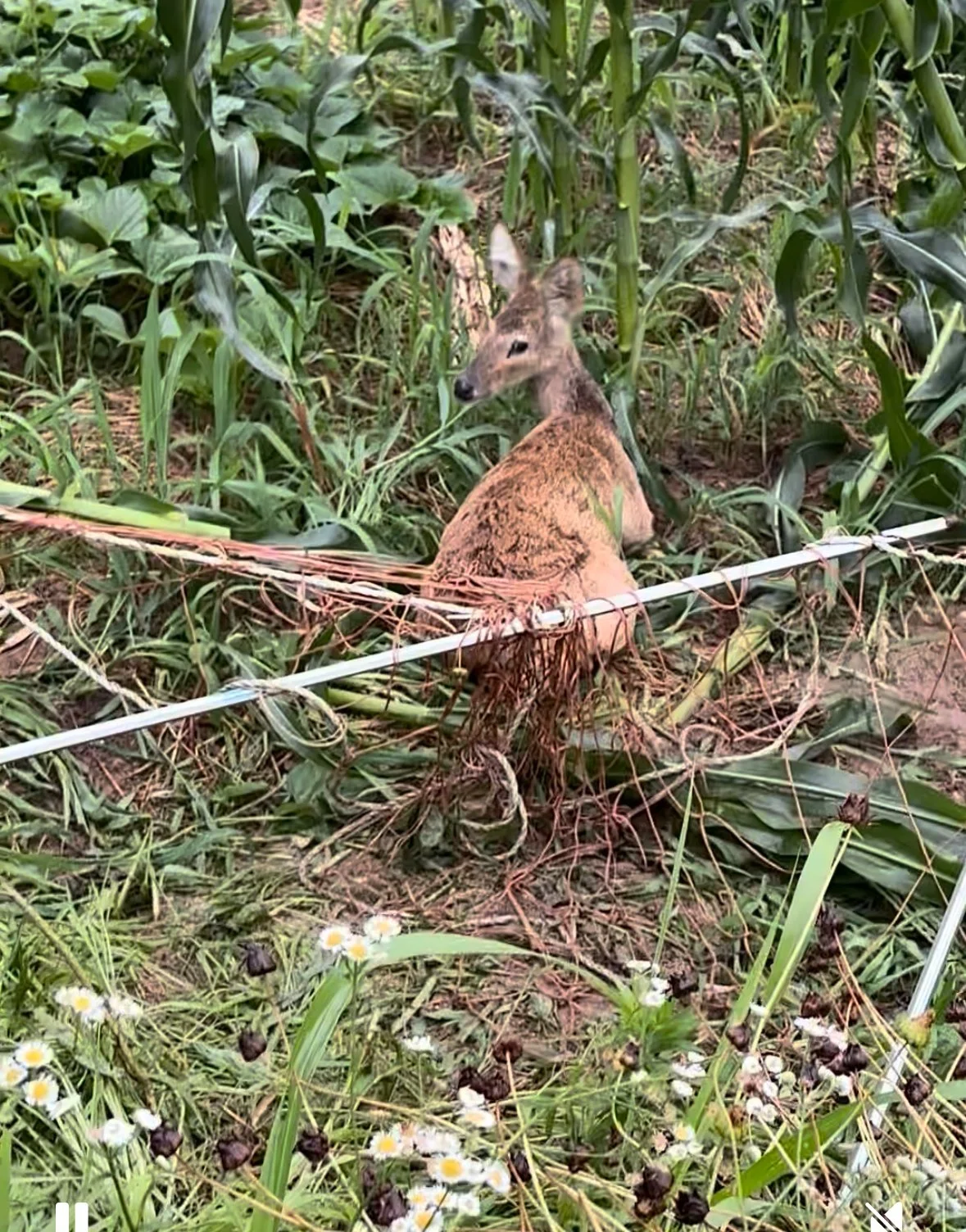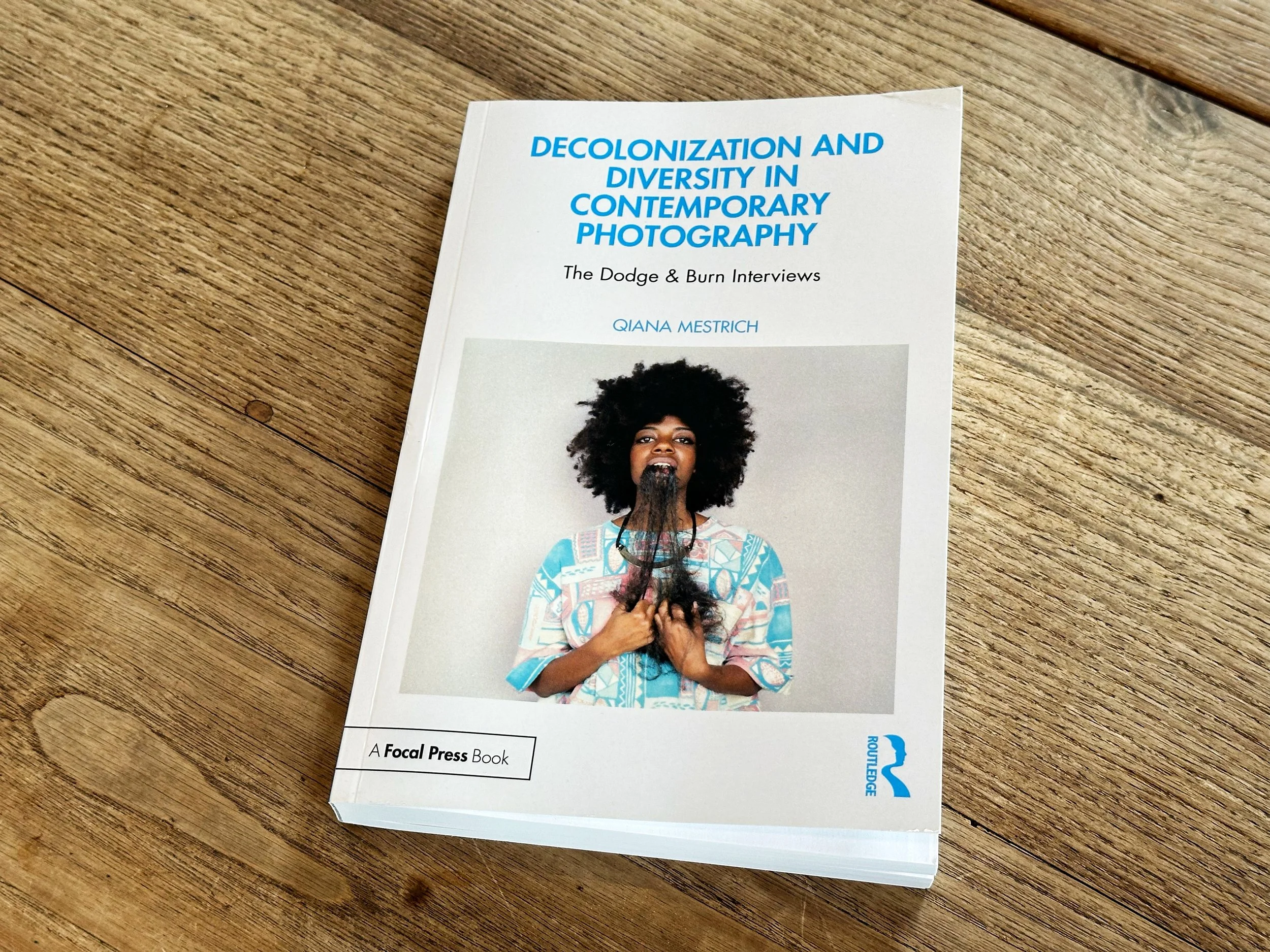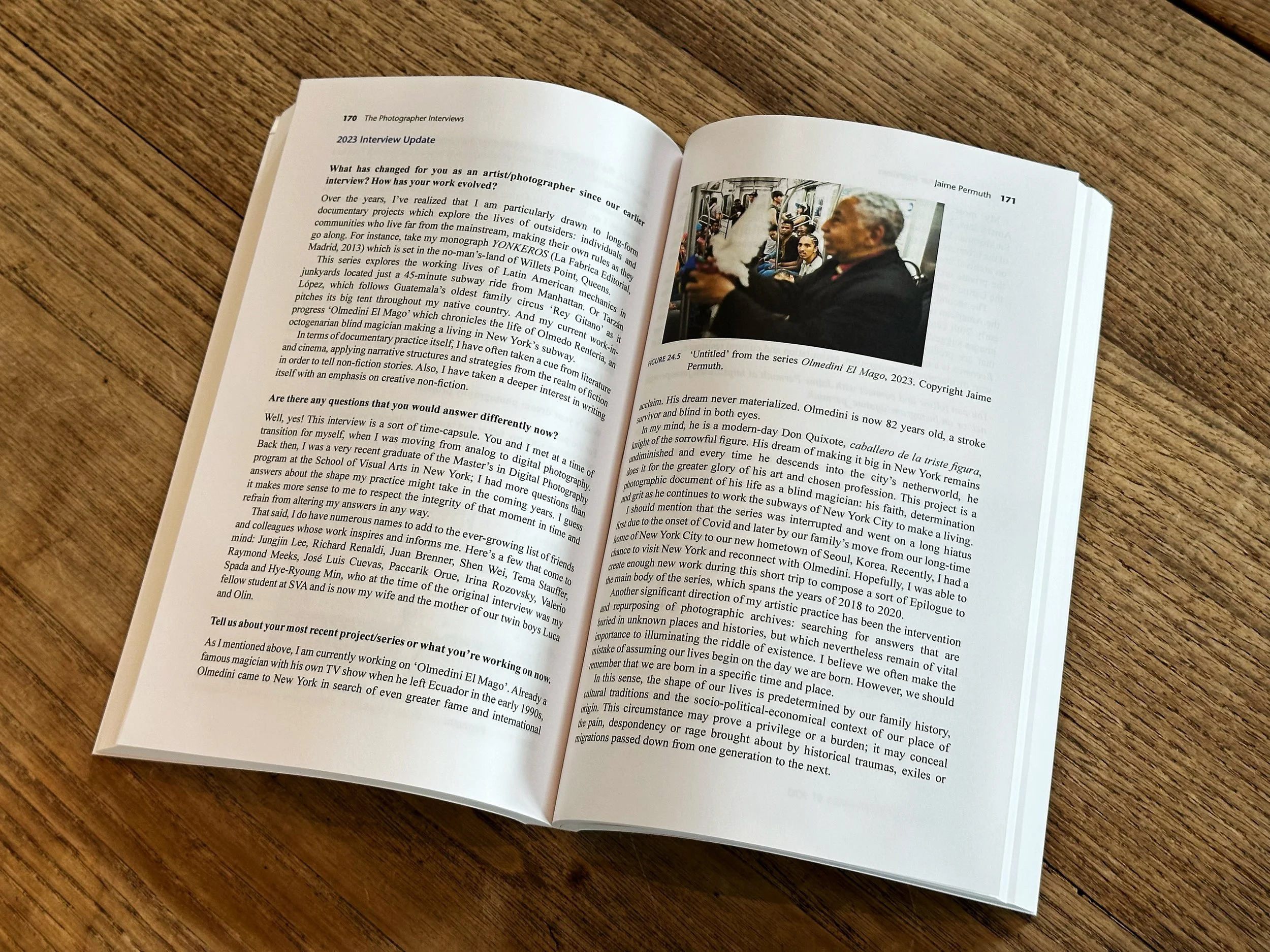A beautifully realized catalogue is a great way to bring together the scope of a photo festival. That is surely the case for this year’s edition of the DongGang International Photo Festival ~
In a neighbor’s field
Yesterday, Olin woke up early, a full hour and a half before his usual time. I tried to help him get back to sleep. It was úseless. So instead, I proposed we go out for a walk together.
Olin was of course on the lookout for insects but instead we found a deer crouching in a neighbor’s field. As we got closer, the deer jumped out and tried to get away. But the poor thing was badly tangled in a mesh fence. I got closer and it allowed me to pry one of its hind hooves loose. But the rest of the legs were hopelessly caught in the mesh. Every time it jumped forward the rope cut deeper into its skin.
We ran back home so I could grab my pocket knife. We returned to the field and I carefully cut it loose. The deer took a few steps and pitched forward on the ground, badly hurt.
I then contacted the Town Hall. They said they would send someone over. What I didn’t know is that the town sees these deer as a problem for farmers and more often than not, they simply put them down where they find them.
The whole experience made an impression on me: the animal’s delicate head and beautiful coloring, its panic at feeling trapped, its grudging trust in me, the welts and open gashes on its skin, its feeble attempts to regain its footing.
I wish the ending could have been different.
The Dodge & Burn Interviews
Sometime in 2009, Qiana Mestrich reached out to me asking if I’d be interested in being interviewed for her blog “Dodge & Burn”. The interview, which appeared in September of that year is now featured in print together with an update of several follow-up questions from 2023.
Qiana’s blog zeroed in on individual artistic practices vis-a-vis an art world that was reluctant to embrace the vision of immigrants and artists of color. Reading Qiana’s posts one immediately felt a strong and unapologetic sense of advocacy, insisting on decolonizing the gaze of gatekeepers and fighting for greater diversity, equality and inclusion.
My interview from 15 years ago feels like a time capsule and I decided to keep it without alterations. Looking back, I feel that I’m often over-confident and naive and hungry like only young artists can be. I hope my postscript balances things out a bit better with the perspective and clarity of a long artistic career.
At any rate, dear Qiana, I salute your talent and tireless work. And I celebrate this publication with you. Its pages tell it like it is and are full of insight and inspiration. I am humbled and honored to be included in it alongside so many friends and colleagues I cherish and admire.
Rosalind Solomon, in memoriam
In the mid 90s, when I completed my MFA studies at the School of Visual Arts in New York, I went to work as a personal printer for some of the photographers I admired most at the time.
First for Patrick Demarchelier, working on his fine art exhibitions. Then I printed books and exhibitions for Lois Greenfield and subsequently for Gilles Peress. Soon after I had stopped working for Gilles - to focus on my own personal work - I got a call from him.
He explained that Rosalind Solomon had just returned from Johannesburg and needed help printing a portfolio. I confessed I didn’t know her work. Gilles said it might be an interesting experience for me to work on her images.
That was an understatement. To step into her world, to become intimate with her work, to spend time with the artist, it was all a revelation.
Rosalind came to photography later in life but she left an indelible mark on the medium. She was a true visionary and one of the most uncompromising artists I’ve ever met. She held herself - and all those she collaborated with - to the highest standards.
When the portfolio was done, we still kept in touch. Sometimes, if I was passing by her Astor Place studio I would ring her doorbell and come up to see her for a bit. Other times, I would bring a bottle of wine and settle in for a longer conversation.
In her later years, Rosalind became more and more interested in the human voice. She embraced both writing and performance as part of her practice.
What a legacy she leaves behind. And how sorely she will be missed.
Finalist DIPF
Thrilled to be a Finalist for this year’s DongGang International Photo Festival ~
Los pasos de sus dueños
Por supuesto, los libros cuentan las historias que llevan impresas en sus páginas. Pero muy a menudo recuerdan los pasos de sus dueños también.
En el 2009, viajé a Madrid para supervisar la impresión del libro “Julio Zadik, un fotógrafo moderno en Guatemala” en Gráficas Palermo. Llevaba conmigo “Travesuras de la niña mala” de Vargas Llosa, y al abrirlo aún conserva parte del boleto de Iberia que utilizaba de seña. Dieciséis años más tarde lo volví a leer en Corea y recordé tantas experiencias vividas en España, donde coincidentemente termina sus días el protagonista del libro.
Mi copia de “El hijo de casa” de Dante Liano contiene un recibo muy simple escrito a mano. El libro lo compré en Guatemala poco antes de viajar por primera vez a Cuba. Y leí su tenebroso relato en la Calle Neptuno en Centro Habana.
El recibo indica el costo de la estadía de siete noches en Casa Miriam y Sinaí, y está escrito de la mano de Miriam. No solo figura el costo de mi habitación sino la de varios de mis estudiantes que me acompañaban en el taller que impartí en esa ocasión.
Once años más tarde lo vuelvo a leer una vez más. Mis memorias de Cuba en ese primer viaje, se mezclan con el aire muy puro y las noches tranquilas del campo en Corea.
Preface
“Permuth’s world is wholly night. His night is not merely the absence of sunlight. It is a moment when reality sheds its skin and the truth beneath begins to emerge. Though documenting scenes of Cuba, Permuth transcends documentary realism. Referencing Milton’s “darkness visible,” he emphasizes blindness as a mode of perception. He makes visible the darkness within daylight and reveals the visible in the pitch-black night. The “majestic, aged, and crumbling landscape” of Havana’s old quarter unsettles and enthralls the artist, as noted in his statement. This emotional disorientation—where boundaries collapse—is daytime imbued with night. In Centro Habana, where open windows and doors erase the division between inside and outside, darkness gathers thick as ink between flickering streetlights. Glimpses of brightly lit interiors through open doors are at once outside and inside. For Permuth, everything is night—a space where the real and the unreal, clarity and delirium, despair and ecstasy coexist. He captures these fleeting nights in photographs. Night is despair, and also hope. It is both destination and departure. Only by sleeping can we awaken; only by embracing night can we anticipate morning. The long journey into night is a black love, a descent into despair. Yet by accepting our fate and arriving at night, we begin to dream again. Night is the detour of life”.
From Lev Ahn’s preface to the exhibition “Long Day’s Journey Into Night” @iseurrat Iseurrat Artroom.
Sebastiao Salgado, In Memoriam
There was a time in my life, around twelve or thirteen years of age, when my interest in photography started to deepen and become a passion. I treasured every roll of film in my camera and each frame counted. Seeing a contact sheet felt like reading pages from a diary because I had managed to stretch those 36 frames over a week or two, sometimes even longer.
Back then, I was open and susceptible in the way that only the youngest hearts can be. And the works of the great photographers, whom I had never met in person, were voices that whispered to me like the closest of friends.
Some were so mighty that I could hardly reconcile the fact that - like me - they worked with a camera. Could these be photographs too? Their images seemed to emanate from a higher and unattainable realm, even though they were firmly rooted in the same world I walked.
I encountered Sebastiao Salgado’s photography for the first time in the most unlikely way: a poster hung in a classroom of a woman and her children traversing a barren landscape in Africa. The figures were unevenly distributed over the field, and wrapped in coarse sheaths of cotton fabric. Only their faces were visible and they seemed exhausted and emaciated by their journey. They were walking together but in a fragile manner, at risk of falling apart. Overhead, the darkening dome of the sky glowed with delicate, compassionate and diaphanous light.
Even though I was on my way to meeting friends, it broke my stride. I don’t recall how long I gazed at it in silent wonder. There was a feeling of sacredness to the photograph and experiencing it was an epiphany that changed me forever. Over the years, it would be followed by others, just as powerful.
Sebastiao Salgado, you were and will always be an inspiration. I never thought of you as a journalist. I always considered you a poet. Farewell, and thank you for so much.
Upcoming exhibition at Iseurrat Artroom in Seoul
Save the date!
I am part of a three-person exhibition “Long Day’s Journey into Night” opening May 16th at Iseurrat Artroom in Seoul.
The exhibition will feature a dozen of my street photographs from Havana, as well as a selection of works by painters Jooyoung Park and Sera Jeong.
Broccoli (and fatherhood)
This past Friday, HRM was invited to give a talk at Raffaella Gallo’s ARTCaffè. One of the projects she referenced was her most recent body of work, The Hours Breathe.
The series is a deeply felt meditation on motherhood. Hearing her speak of those days brought back a flood of memories.
During the Q+A after the talk, an older man asked her a very perceptive question about how returning to Korea after spending so many years abroad had impacted her perceptions of her own country.
Later on, as the audience was dispersing, we had a chance to speak with him. He told us a very moving story. A week earlier, at home in Montreal, he got a telephone call from his son in Seoul. “Dad, what are you doing next weekend?”
“Nothing special, son”.
It turns out his daughter in law, who was also in the audience on Friday, was scheduled for surgery and his son flew him in for a few days to help care for his young grandson. For some reason, hearing the man tell his story almost brought me to tears.
And I haven’t been able to stop thinking of my own early days as a father.
Tonight, as I was doing the dishes after dinner, I suddenly had a vivid recollection of myself in the vegetable aisle at Harlem Whole Foods, with baby Luca strapped on to a backpack across my chest, carefully choosing the best broccoli I could find to puree for the twins at home.
God, there were some sleepless nights back then. And I remember being so bone-tired that I might as well have been sleep-walking through my life.
But what immeasurable joy filled our hearts as well.
Publication in Lente Cubano
Gracias Lisset Alonso Compte for including my work in this review of the exhibition “Expansión” at Centro de Arte Contemporáneo Wilfredo Lam, published in the journal Lente Cubano.
Ingam Dojang
Today was a true rite of passage for me.
Having now lived in Korea for a few years, it suddenly became necessary for me to get an Ingam Dojang (인감도장) which is a registered personal seal or stamp used here to authenticate important legal documents, similar to a signature in Western contexts.
I chose a case for my seal decorated with the “Sipjangsaeng” the ten symbols of longevity. Sipjangsaeng (십장생) refers to the “Ten Symbols of Longevity” in Korean culture, a traditional motif representing eternal life, health, and happiness. The term combines “sip” (십), meaning “ten,” and “jangsaeng” (장생), meaning “long life.”
These symbols typically include the sun, mountains, water, clouds, pine trees, turtles, cranes, deer, bamboo, and plants of immortality.
With the help of a shop owner in nearby Hwado, we designed the seal. Given that I am not a Korean national, it was required to have my full name spelled out Western style. I only ever use my middle name “Enrique” in the context of official documents. And today was no exception.
Pictures from an exhibition
Yesterday was Opening Night for the exhibition “Expansión 15” organized by La Bienal de la Habana and installed at the Centro de Arte Contemporáneo Wilfredo Lam.
I wish I was there to hear Nelson Ramirez de Arellano’s introductory remarks and to celebrate with my fellow resident artists at Casa Naranja, Osmany, Natasha, Adrian and Rosa.
Most of all, I wish I had been there in person to welcome the audience and have a chance to hear their impressions of the work. And also, to take it all in myself, because CAC Wilfredo Lam is my favorite museum in Cuba and I had longed for many years to exhibit my photographs at that storied institution.
Habana holds a very special place in my heart and this exhibition- albeit in absentia - feels like a homecoming.
Opening Night in Habana
Ten photographs from my series “Quisicuaba”, commissioned for the 15th Bienal de La Habana, are included in the exhibition “Expansión de la Bienal”.
The show opens 3/21 at Centro de Arte Contemporáneo Wilfredo Lam.
Saturday night in Munhori
My first Saturday night in Munhori. All is quiet around me. Gone are the neon lights, the heavy hum of street traffic, the feeling of looking down at the city from the far remove of a 15th floor balcony.
The darkness around me is broken only by the lit windows of a dozen or so neighboring houses.
I pour myself a glass of Zacapa, light my last Cuban cigar and step out onto our porch to think about all the changes our family is going through.
I get lost in a cloud of blue smoke, taste the sweetness and nostalgia for Guatemala in the rum and let the intoxication and reverie wash over me.
The red wheelbarrow
I’m a die-hard, life-long city dweller, urban-addict kind of guy. And yet, today we left the city for the countryside.
For the most part, the move is a function of being closer to Jaime Stay. But also, HRM and I know how much our kids love the natural world and we think their new life surrounded by mountains, valleys and streams on a daily basis will bring them great joy.
So we’re taking a leap of faith and trying this out.
Hello country life!
Brace
Two days ago a snowstorm rolled into town. The temperatures were double digits below zero Celsius and it was bitterly cold as we were walking back home with the boys at the end of the school day. The snow itself was powdery on the surface but there were invisible patches of ice underneath.
Just as we were about to reach our building, I slipped and hit the ground. My hands were busy with their book bags and I couldn’t break the fall properly. So I now have a torn ligament in my left hand and am looking at three weeks wearing this brace.
This morning we walked by the same spot were I fell. Without a word, Luca reached for my right hand and held it tightly in his, wanting to make sure I wouldn’t fall once again.
It reminded me of how in Korea parents are referred to in relation to their children; to anyone in the neighborhood, I’m not Jaime. I’m “Olin and Luca’s father”. I love hearing that. It always makes me think that people recognize that being their father is my greatest accomplishment.
My room in Quisicuaba
“I settle into a room equipped with a dozen beds. I choose one to sleep in and use another to lay out my belongings. Every morning, one of the residents, nicknamed “Camagüey”, knocks on my door and leaves me a bucket of hot water to bathe with.
We have conversations over breakfast. Sometimes I read a book or work on the portraits and texts. There are several couples who have met here. One of them, Olga and Liban, are passionate about drawing and writing. After a few days, they hand me illustrations on cardboard intended for the book’s cover and back cover, along with a portrait of myself where I appear with a large Olmec-style face, Slavic eyes, and the hat I wear every day.”
Guest book
Yesterday’s entry from our guest book at Jaime Stay is the landscape outside the windows of Luca House drawn using coffee instead of ink. The Korean script translates as “Drunk on the landscape”.
Did I mention we love our guests?
Happy Lunar New Year!
새해 복 많이 받으세요!
https://www.stayfolio.com/en/findstay/jaime-stay?utm_source=link&utm_medium=share&utm_campaign=findstay&utm_content=jaime-stay
Playlist
New year, new concept for our Gwanghapdan zines!
We have reimagined, redesigned and repurposed our zine making. Also, we are calling them “playlists” and they will be published quarterly.
Here’s a sneak peek at our Winter Playlist ;)
Artist Talk coming up at Wit and Cynical Bookstore in Seoul, Korea on Jan 24th 7:30PM. Free admission and free poster!

